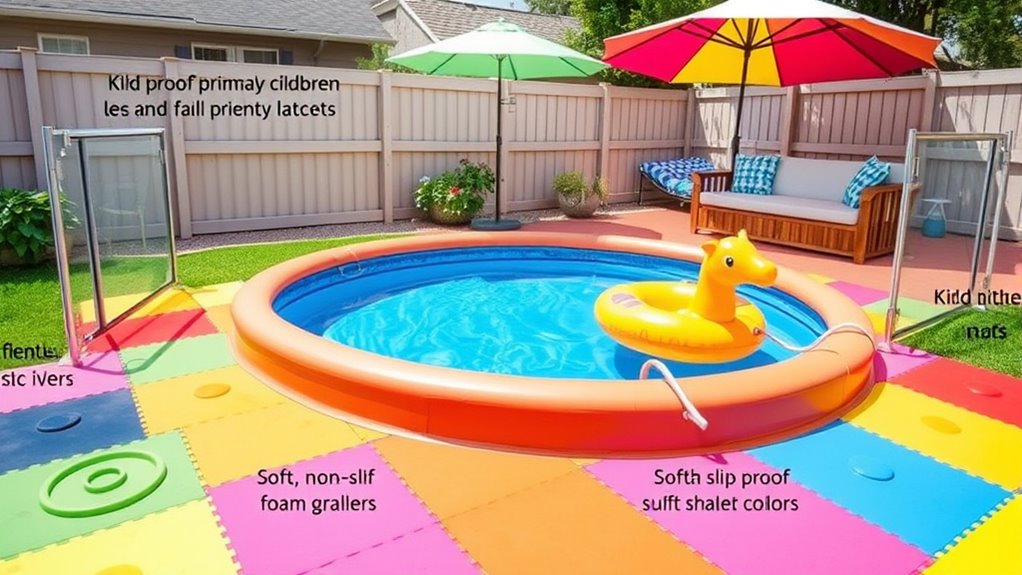To create a kid-friendly pool, focus on shallow zones no deeper than three feet, with gradual slopes for safe access. Incorporate water features like splash pads and fountains in those areas to keep children engaged. Install secure barriers, such as fences with self-latching gates, and keep rescue gear nearby. Good lighting, clear supervision, and safety alarms further enhance security. Stay tuned to discover how to combine these features for a safe, fun swimming environment that keeps children protected at all times.
Key Takeaways
- Design shallow zones no deeper than three feet with gradual slopes for safe, easy access and water play.
- Incorporate water features like fountains and splash pads within shallow areas to enhance fun and safety.
- Install secure fencing with self-latching gates and physical barriers around the pool for added safety.
- Ensure proper lighting, unobstructed views, and accessible safety equipment to improve supervision and response.
- Use slip-resistant materials for water play elements and maintain clear boundaries to prevent accidental entry into deeper water.

Creating a safe and enjoyable swimming environment for kids starts with smart pool designs and essential safety features. When planning your pool, prioritize areas specifically designed for water play and shallow zones. These areas are perfect for young swimmers who are still gaining confidence in the water. Shallow zones, typically no deeper than three feet, allow children to play freely while minimizing the risk of accidents. By clearly defining these zones, you give kids a safe space to splash, explore, and learn to swim without constant supervision.
Design pools with designated shallow zones and water play areas for safer, confidence-building fun for young swimmers.
Incorporating water play features adds to the fun but also requires careful planning. Features like fountains, gentle waterfalls, or splash pads should be positioned within shallow areas to prevent children from venturing into deeper water prematurely. These features not only entertain but also encourage water familiarity and comfort. Make sure the water play elements are made from child-safe, slip-resistant materials to prevent falls or injuries. Designing the pool with a gradual slope from shallow to deeper waters ensures kids can enjoy water play without sudden drops, giving them a sense of security as they develop their swimming skills.
Safety barriers are essential in maintaining these designated zones. Fencing around the pool area, with self-latching gates, prevents unsupervised access by children and pets. Using a barrier that is at least four feet tall helps keep curious little ones out when an adult isn’t watching. When kids are within the pool, constant supervision is key, but physical barriers provide an added layer of security. Additionally, installing a pool cover that is easy to use and secure can prevent accidental falls into the water when the pool isn’t in use.
Beyond physical features, implementing safety devices is fundamental. Keep rescue equipment like life rings, reaching poles, and first aid kits nearby and accessible. Use pool alarms that alert you if someone enters the water unexpectedly, especially in larger pools with water play zones. It’s also wise to teach children basic water safety rules early on, so they understand boundaries and the importance of staying within designated safe zones.
Finally, maintain clear visibility across the entire pool area. Avoid clutter around shallow zones and water play features, ensuring you always have an unobstructed view. Good lighting is essential for evening swims, enhancing safety and allowing you to monitor kids easily. With thoughtful design, appropriate safety features, and vigilant supervision, you create a pool environment that kids can enjoy safely, making every swim fun and worry-free. Regular maintenance of pool safety equipment also ensures it remains in good working order and ready for use in an emergency.
Frequently Asked Questions
What Are the Best Non-Slip Pool Surface Options for Kids?
You should consider choosing the best non-slip pool surface options for kids by focusing on safe pool surface materials and slip-resistant coatings. Look for textured concrete, rubber, or vinyl pool surfaces that provide excellent traction. Applying slip-resistant coatings enhances safety further, reducing slip hazards. These options make certain your kids can enjoy the pool area confidently, minimizing accidents and providing peace of mind during pool play.
How Can I Prevent Kids From Climbing Over Pool Fences?
To prevent kids from climbing over pool fences, you can install childproof locks on gates and make sure the fence meets height requirements, typically at least 4 feet tall. Regularly check the locks and fence for wear or damage, and consider adding additional barriers like pool alarms. Keep supervision constant, and educate kids about safety rules around the pool area to further reduce risks.
Are There Eco-Friendly Safety Features for Children’s Pools?
You might think eco-friendly safety features for children’s pools are a dream, but they’re real! Instead of harmful chemicals, you can use biodegradable toys, which are safer for kids and the environment. Solar heating offers a sustainable way to warm the water without electricity. These features combine safety and eco-consciousness, proving that caring for nature and children can go hand in hand. After all, why not protect future generations?
What Are the Maintenance Tips for Child-Safe Pool Equipment?
To maintain child-safe pool equipment, you should focus on regular pool cleaning to prevent algae and bacteria buildup. Check equipment durability frequently, ensuring filters, pumps, and safety covers are in good condition. Follow manufacturer guidelines for routine maintenance, replace worn parts promptly, and keep the area clear of debris. Proper upkeep not only extends equipment lifespan but also keeps your pool safe and inviting for children.
How Do I Select the Right Pool Size for Young Children?
When selecting the appropriate pool size for young children, consider pool depth to guarantee safety and ease of supervision. Opt for shallow areas or gradual slopes to prevent accidents. You should also explore various pool shape options, like rectangular or freeform designs, to maximize space and accessibility. Always think about your yard size and how much area you want to allocate, making sure the pool fits comfortably while providing a fun, safe environment.
Conclusion
With these kid-friendly pool designs and safety features, you create a safe, inviting oasis where your children can splash and play freely. Picture the gentle ripples of water reflecting sunlight, a secure shallow area just for them, and sturdy barriers that keep worries at bay. As you watch their joyful laughter bounce off the water’s surface, you’ll feel confident knowing you’ve built a fun, safe haven where memories are made and safety is always a priority.









